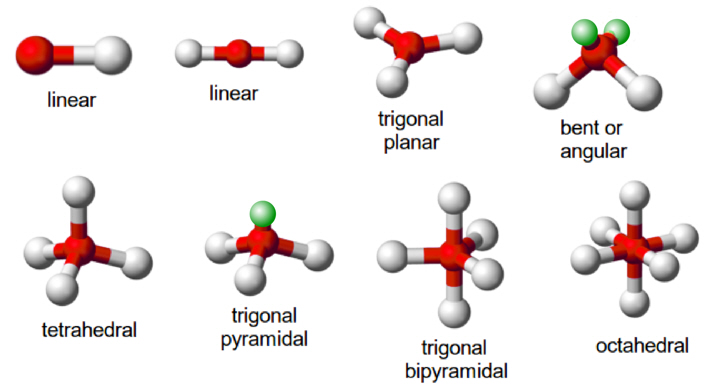Chemical Bonding and Shape of Molecules


Ionic Bonding
↪ Ionic bonding is a type of chemical bonding which involves a transfer of electrons from one atom or molecule to another.
↪ Here, an atom loses an electron which is in turn gained by another atom.
Examples of formation of ionic bonds
Formation of sodium chloride (NaCl)
↪ The electronic configuration of sodium is 2, 8, 1.
↪ It has one more electron than its nearest noble gas (Ne).
↪ Therefore, it loses one electron from valence shell to attain the electronic configuration of Ne (2, 8). On doing so, Na (2, 8, 1) forms Na+ (2, 8) ion.
↪ The electronic configuration of chlorine (Cl) is 2, 8, 7. It has one electron less than its nearest noble gas (Ar).
↪ Therefore, it gains one electron on its valence shell to attain the electronic configuration of AR (2, 8, 8). On doing so, Cl (2, 8, 7) forms Cl− (2, 8, 8) ion.
↪ Now, Na+ and Cl− combine together to form NaCl. The formation of NaCl can be shown by electronic configuration as:


Properties of an Ionic Bond
Due to the presence of a strong force of attraction between cations and anions in ionic bonded molecules, we observe the following properties:
↪ The ionic bonds are the strongest of all the bonds.
↪ The ionic bonds have a charge separation. So, they are the most reactive of all the bonds in the proper medium.
↪ The ionic bonded molecules have high melting and boiling point.
↪ The ionic bonded molecules in their aqueous solutions or in the molten state are good conductors of electricity. This is due to the presence of ions which acts as charge carriers.
Covalent Bonding
↪ A bond formed by the mutual sharing of equal number of valence electrons between two atoms of the same or different elements such that each of combining atoms attain octet state is called covalent bond..
↪ A compound formed by this mode of bond formation is called covalent compounds and the total number of electrons of an atom involved in the sharing is called covalency.
Properties of Covalent Bond
If the normal valence of an atom is not satisfied by sharing a single electron pair between atoms, the atoms may share more than one electron pair between them. Some of the properties of covalent bonds are:
Depending upon the number of shared electron pairs, the covalent bond can be classified into:
Single Bonds
↪ A single bond is formed when only one pair of the electron is shared between the two participating atoms. It is represented by one dash (-).
↪ Although this form of covalent bond has a smaller density and is weaker than a double and triple bond, it is the most stable.
↪ For Example, HCL molecule has one Hydrogen atom with one valence electron and one Chlorine atom with seven valence electrons.
↪ In this case, a single bond is formed between hydrogen and chlorine by sharing one electron.
Double Bonds
↪ A double bond is formed when two pairs of electrons are shared between the two participating atoms.
↪ It is represented by two dashes (=). Double covalent bonds are much stronger than a single bond, but they are less stable.
↪ Example: Carbon dioxide molecule has one carbon atom with six valence electrons and two oxygen atom with four valence electrons.
↪ To complete its octet, carbon shares two of its valence electrons with one oxygen atom and two with another oxygen atom.
↪ Each oxygen atom shares its two electrons with carbon and therefore there are two double bonds in CO2.
CO2 Molecule with Double Covalent bond
Oxygen-Molecule:
↪ In the formation of the oxygen molecule, each oxygen atom has six electrons in their valence shell. Each atom requires two more electrons to complete their octet.
↪ Therefore. the atoms share two electrons each to form the oxygen molecule. Since two electron pairs are shared there is a double bond between the two oxygen atoms.

O2 Molecule with Double Covalent bond
Triple Bond
↪ A triple bond is formed when three pairs of electrons are shared between the two participating atoms.
↪ Triple covalent bonds are represented by three dashes (≡) and are the least stable types of covalent bonds.
For Example:
formation of a nitrogen molecule,
Nitrogen Molecule with Triple Bond